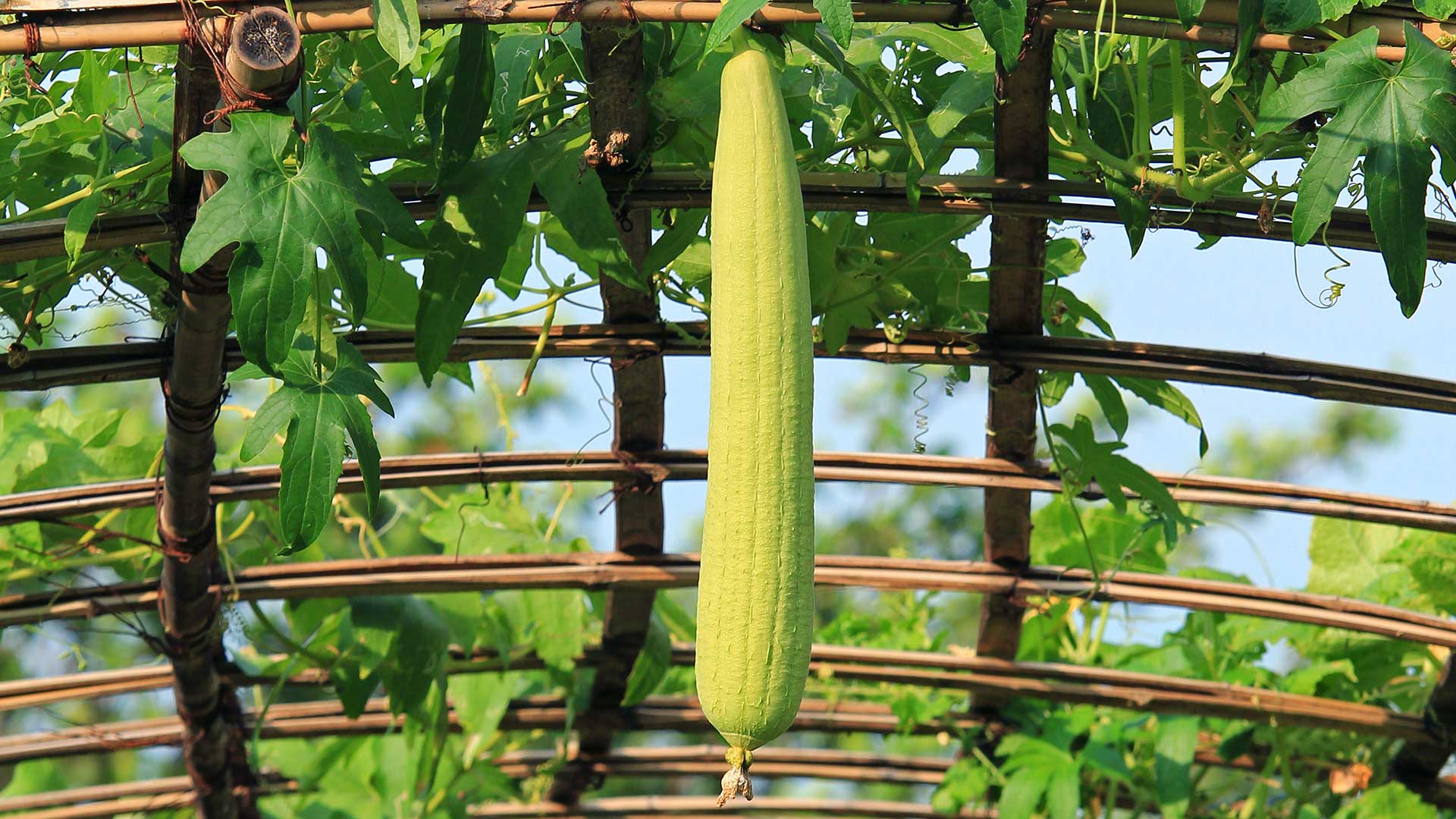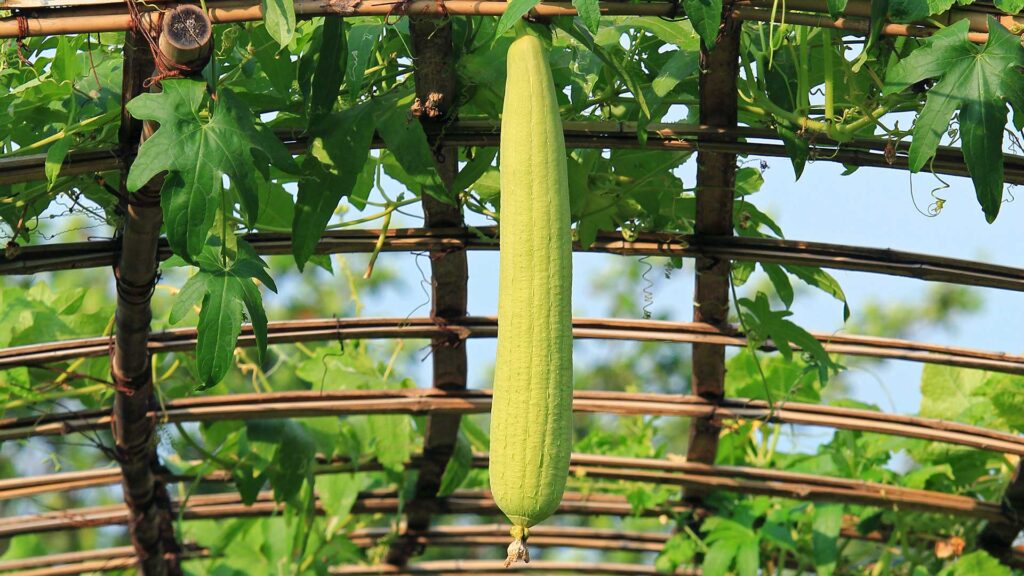When you think about those adorable, exfoliating loofah (common name) scrubbers, a gourd probably does not come to mind. But indeed, Luffa aegyptiaca, Luffa cylindrica, Luffa acutangula, and Luffa operculata are related to squash and cucumbers, all members of the same Cucurbitaceae family. Luffa aegyptiaca and Luffa cylindrica are often used interchangeably and although there are differences, both have a similarly smooth and cylindrical fruit shape. Luffa acutangula is an elongated loofah with sharply angled ribs or edges. Luffa operculata, or wild luffa, has rotund fruits about the size of a plum with interesting spikes on the outer surface.
All Luffas can be eaten when fruit are young but are often grown out to harvest the inedible, rough, fibrous tissue that develops after the fruit matures. The early fruit, resembling a summer squash or cucumber in preparation and flavor, is best when harvested between one-to-two-inches in diameter and may be prepared with or without the outer skin removed. Some are better tasting than others. If you are growing for edible quality, trial many and choose the better tasting ones. Allow a few of the delicious ones to mature and save the seeds.
Luffa plants are thought to have originated in Asia, Northern Africa, and the Middle East. It is possible to somewhat mimic natural growing conditions if plants are provided with enough heat, water, and food. More difficult to provide is an adequate growing season. If you are in hardiness zone 6 or colder, plan to accommodate for the needed length of the growing season, which is 150 – 200 days, by starting seeds indoors. Luffas are quite susceptible to cold, so plan to give them the needed time on the front end of the planting season to ensure a better chance at successful fruit production. If you do plan to grow seedlings indoors for a month or more, start the seeds in a five-to-six-inch biodegradable pot to eliminate unnecessary transplant roughness to the roots. Take note that cucurbits do not like anyone messing with their undercarriage. Disturbances to the roots are met with disdain so when thinning undesired seedlings, cut them off at the soil level – do not pull.
How to grow? Luffa are very similar in needs to other members of the Cucurbit family. Plant seeds ½” to ¾” deep in warm 70-degree F soil; keep the surrounding air at a temperature of 65-to70-degrees F. Provide plenty of food, beginning fertilization as the seedlings develop their second set of true leaves. While they do need plenty of water, make sure the pots are adequately drained with no standing water on the roots.
Give Luffas at least six to ten feet of vertical space to spread upward, spacing the plants about a foot apart on a solid, multi-point system. As the vines grow, removing the first four lateral shoots above the soil surface will strengthen the main stem and provide a good base structure for fruit development. Luffas are an annual vine but quickly develop a heavy growing stem with heavy fruits that will need plenty of support along the way. Although a single runner support e.g., wire or fabric lines, may be used, Luffas develop more and better fruit when provided a solid structure with many points of support e.g., trellis or chain link fencing. Heavy posts are a good idea to support the weight if planting many vines together.
A monoecious plant, Luffas have both male and female flowers on each vine. The differences are easy to distinguish in that the male flowers develop and show in clusters, while the females are single flowers. Male flowers will begin to develop and emerge earlier than the females. Do not despair if fruit does not show directly after the first beautiful yellow blooms appear. Those are the eager males looking for a bit of early love.
When to harvest the mature fruits? Watch for a weight and color change on the fruit. The outer skin will start to take on a yellowish hue and become noticeably lighter in weight when gently hefted. Water content diminishes and what was once a heavy, pendulous blob becomes a lightweight producer of potential scrubbers. The drying fruits can be left on the vine to mellow and dry or they can be picked as they mature. They are ready to peel, deseed, and clean when the fruit gives off a dry, skin-popping sound when squeezed about the middle.
Removing the peel is necessary to access the inside fiber. There are a couple of different techniques for peeling Luffas. One is to grab one of the veins and pull as you would a zipper, cracking and removing the outer, dry skin until all is removed. Shake the dry, deshelled fruit over a clean surface to dislodge the seeds. Pick through, choosing the healthiest looking seeds to save for next season. Another method for peeling is to soak the mature, dry fruits in a bucket of water until skins soften and begin to peel away, removing as it loosens. With this technique, the seeds do get wet and will need to be dried before saving.
After the seeds are removed, wash the remaining fibrous tissue to remove any extraneous matter and air dry the cleaned tissue. Some growers prefer to bleach loofahs to a lighter color, but it is not a necessity, as they are ready for immediate use as is. Keep dry for long term storage. Voila! You have homegrown loofahs.
All Luffas will produce some form of fibrous tissue at maturity and as a bonus, the seeds are edible for humans and wildlife at all growth phases. Minimal waste with this crop.
As a note of caution: Luffas can be invasive in very warm climates so choose carefully.

